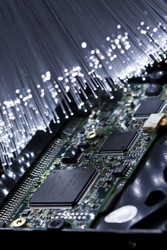All-optical computing on its way?
Computers have come a long way in the past decade, and the way digital computations are performed may also be changing as technology progresses. Optical computer systems, for example, use photons of visual light or infrared beams instead of traditional electrons used in most computers today. There have already been solid efforts to develop optical components that can replace traditional components in creating a hybrid optical/electronic system. Ideally, a completely optical system, known as all-optical computing, would be a much more efficient solution and the epitome of advancement in this field. The EU-funded MUFINS project combined eight European research groups to create optical switching systems - or all-optical gates - for this purpose. The project involved a variety of tests to develop optical technology matching different applications. Indeed, MUFINS ensured that the developed multi-gate elements will have an adequate market to support high-tech applications in products upon completion of the project. This was made possible thanks to the several different types of devices and chips that were developed. These advances have made the dream of all-optical processing much more tangible than before. They have also offered improvements to existing specialised applications in high data-rate telecommunications and networking, particularly those that can benefit from high-speed, low-complexity all-optical circuits. In short, MUFINS is a robust demonstration of how Europe is rethinking computers and how digital technology can become much more efficient. One day, all our computers may feature this novel technology.







